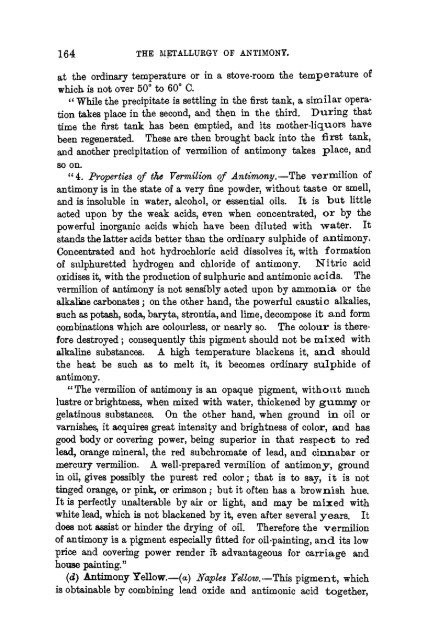antimony - Sciencemadness.org
antimony - Sciencemadness.org
antimony - Sciencemadness.org
You also want an ePaper? Increase the reach of your titles
YUMPU automatically turns print PDFs into web optimized ePapers that Google loves.
164 THE METALLURGY OF ANTIMONY.<br />
at the ordinary temperature or in a stove-room the temperature of<br />
which is not over 50° to 60° C.<br />
" While the precipitate is settling in the first tank, a similar operation<br />
takes place in the second, and then in the third. During that<br />
time the first tank has been emptied, and its mother-liquors have<br />
been regenerated. These are then brought back into the first tank,<br />
and another precipitation of vermilion of <strong>antimony</strong> takes place, and<br />
so on.<br />
" 4. Properties of the Vermilion of Antimony.—The vermilion of<br />
<strong>antimony</strong> is in the state of a very fine powder, without taste or smell,<br />
and is insoluble in water, alcohol, or essential oils. It is but little<br />
acted upon by the weak acids, even when concentrated, or by the<br />
powerful in<strong>org</strong>anic acids which have been diluted with water. It<br />
stands the latter acids better than the ordinary sulphide of <strong>antimony</strong>.<br />
Concentrated and hot hydrochloric acid dissolves it, with formation<br />
of sulphuretted hydrogen and chloride of <strong>antimony</strong>. Nitric acid<br />
oxidises it, with the production of sulphuric and antimonic acids. The<br />
vermilion of <strong>antimony</strong> is not sensibly acted upon by ammonia or the<br />
alkaline carbonates; on the other hand, the powerful caustic alkalies,<br />
such as potash, soda, baryta, strontia, and lime, decompose it and form<br />
combinations which are colourless, or nearly so. The colour is therefore<br />
destroyed; consequently this pigment should not be mixed with<br />
alkaline substances. A high temperature blackens it, and should<br />
the heat be such as to melt it, it becomes ordinary sulphide of<br />
<strong>antimony</strong>.<br />
" The vermilion of <strong>antimony</strong> is an opaque pigment, without much<br />
lustre or brightness, when mixed with water, thickened by gummy or<br />
gelatinous substances. On the other hand, when ground in oil or<br />
varnishes, it acquires great intensity and brightness of color, and has<br />
good body or covering power, being superior in that respect to red<br />
lead, orange mineral, the red subchromate of lead, and cinnabar or<br />
mercury vermilion. A well-prepared vermilion of <strong>antimony</strong>, ground<br />
in oil, gives possibly the purest red color; that is to say, it is not<br />
tinged orange, or pink, or crimson; but it often has a brownish hue.<br />
It is perfectly unalterable by air or light, and may be mixed with<br />
white lead, which is not blackened by it, even after several years. It<br />
does not assist or hinder the drying of oil. Therefore the vermilion<br />
of <strong>antimony</strong> is a pigment especially fitted for oil-painting, and its low<br />
price and covering power render it advantageous for carriage and<br />
house painting."<br />
(d) Antimony Yellow.—(a) Naples Yellow.—This pigment, which<br />
is obtainable by combining lead oxide and antimonic acid together,
















